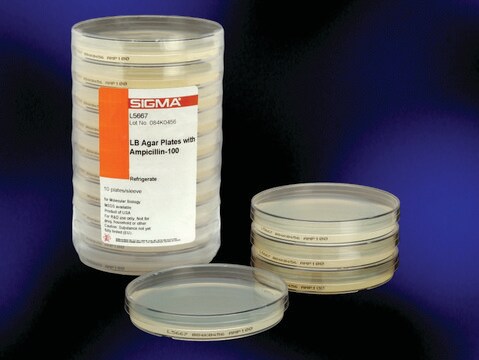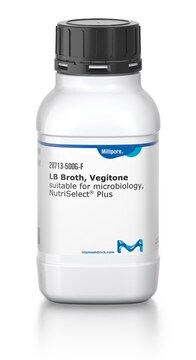L3522
LB Broth (Miller)
Highly-referenced nutrient-rich microbial growth powder medium, suitable for regular E.coli culture
Synonym(s):
Luria Broth, Miller’s LB Broth
About This Item
Recommended Products
grade
for molecular biology
Quality Level
description
Miller′s Modification, 10 g/L NaCl
sterility
non-sterile
form
powder
composition
NaCl, 10 g/L
Tryptone, 10 g/L
Yeast Extract, 5 g/L
pH
6.8-7.2(2.5% solution)
application(s)
food and beverages
storage temp.
room temp
suitability
nonselective for Escherichia coli
nonselective for coliforms
General description
Application
Suitable for non-selective cultivation of E. coli strains for cloning, DNA plasmid production and production of recombinant proteins. Also suitable for selective cultivation when appropriate antibiotics are added.
Biochem/physiol Actions
Features and Benefits
- Easy scale-up using larger package sizes
- A budget-friendly alternative to liquid
- Standard formulation
Preparation Note
2. Autoclave for 15 minutes at 121 °C.
To prepare the medium of Luria, Adams and Ting (also known as LC broth: Aseptically add 25 ml of sterile 0.1 M calcium chloride after autoclaving.
Reconstitution
related product
Storage Class Code
11 - Combustible Solids
WGK
WGK 3
Flash Point(F)
Not applicable
Flash Point(C)
Not applicable
Choose from one of the most recent versions:
Already Own This Product?
Find documentation for the products that you have recently purchased in the Document Library.
Articles
Whole transcriptome amplification (WTA) is a method often used to amplify small quantities of reverse transcribed RNA, or degraded RNA for direct use in Next-Generation Sequencing (NGS) workflows. Discover our SeqPlex™-I WTA library preparation kit for producing libraries that are ready for direct input onto Illumina® NGS flow cells.
The development of genetic engineering and cloning has opened many possibilities of expression and isolation of heterologous proteins for research purposes. Considerable advances in technology have enabled expression and isolation of recombinant proteins in large scale.
Protocols
General protocols for growth of competent cells in microbial medium.
Related Content
KOD One™ PCR Master Mix overview for ultra-fast PCR with high specificity, fidelity, and yield
Our team of scientists has experience in all areas of research including Life Science, Material Science, Chemical Synthesis, Chromatography, Analytical and many others.
Contact Technical Service





